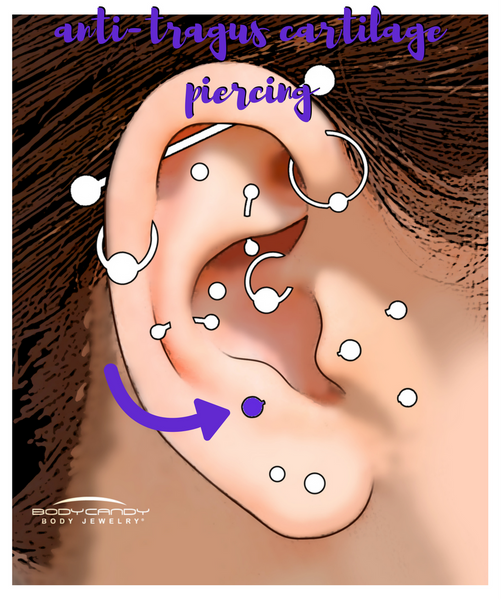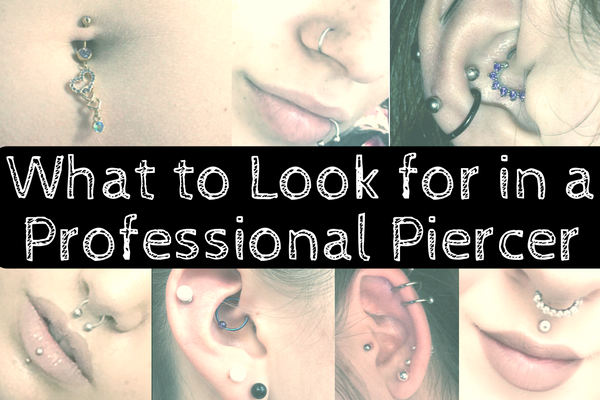
Location: in the small, relatively vertical lip of cartilage above the ear lobe and adjacent to the tragus
Jewelry: initially, a curved barbell or captive ring will be used ranging from 18 gauge (1mm) to 14 gauge (1.6mm) in thickness with a minimum size of 5/16" (8mm) diameter and lengths of 5/16" (8mm) to 3/8" (10mm) usually used; other jewelry types used can include horseshoe circular barbells, circular rings, and straight barbells
Healing: total healing time is anywhere from 3 to 9 months; can be longer
Aftercare: about twice a day, wash with warm water and antibacterial soap; sea salt solutions and sprays can aid with the process and both are recommended for use in an aftercare routine
Formed by the lower frontal rim of the conch of your ear, the anti-tragus' structure and thickness of the cartilage can vary from person to person. Some people may have ears that enable even a double anti-tragus piercing (looks super awesome!) whereas other ears may not have enough surface area to even get an anti-tragus piercing performed at all. For this reason, you'll want to visit your local piercing professional to see what their expertise has to offer as far as what size jewelry you should be pierced with and if the anti-tragus piercing is even an option for you and your ear at all!
Piercing Style Tip: If your ear's anatomy allows for it, try out a rook piercing in combination with the anti-tragus piercing! It'll give an interesting symmetrical look to your cartilage ear candy.
Are you considering getting your anti-tragus pierced but not sure what the actual process entails? Check out the video above from our YouTube channel that shows Kate getting her anti-tragus piercing performed by professional piercer James, from American Skin Art in our hometown of Buffalo, NY.
General Aftercare Tips for Ear Piercings:
- Avoid smoking, using public telephones, and sleeping directly on your new piercing.
- ALWAYS make sure you wash your hands before touching your piercing/its jewelry.
- Resist the urge to change your initial jewelry prematurely - it's worth the wait to do it correctly.
The anti-tragus cartilage piercing is in a location that can potentially cause a lot of irritation and discomfort, especially if this is your first cartilage piercing. You'll definitely want to be sure to sleep on your back or opposite side during the anti-tragus' healing process.
Additionally, piercings in the cartilage of the ear, which lacks an adequate blood supply, makes it more difficult to heal than locations that receive better circulation such as the lobe.
Want to see some awesome options for your anti-tragus piercing whether you just got it pierced or have had it for years?!


We've got you covered here at BodyCandy.com with a ton of cartilage piercing body jewelry to choose from!
WELCOME TO THE BODY PIERCING ENCYCLOPEDIA
This post is included in the Ear Piercing category of our encyclopedia and is joined by many other blog posts about the other piercings available as options in the ear and surrounding areas.
- Standard Ear Lobe Piercing
- Upper Ear Lobe Piercing
- Standard Helix Cartilage Piercing
- Forward Helix Cartilage Piercing
- Rook Cartilage Piercing
- Conch (Inner) Cartilage Piercing
- Flat (Scapha/Outer Conch) Cartilage Piercing
- Daith Cartilage Piercing
- Snug (Anti-Helix) Cartilage Piercing
- Industrial Barbell Cartilage Piercing
- Tragus Cartilage Piercing
- Anti-Tragus Cartilage Piercing
- Surface Tragus Piercing
DISCLAIMER: the styles and locations displayed in the reference images featured in this post won't match perfectly with your ear's shape because each and every person has an anatomy that is uniquely individual and some of the piercings featured in our encyclopedia may not be possible for you to get. To find out what piercings are available for you and your specific anatomy, the best option is to visit your local professional piercer and ask for their expertise in determining what piercings are possible for you and your ear!







